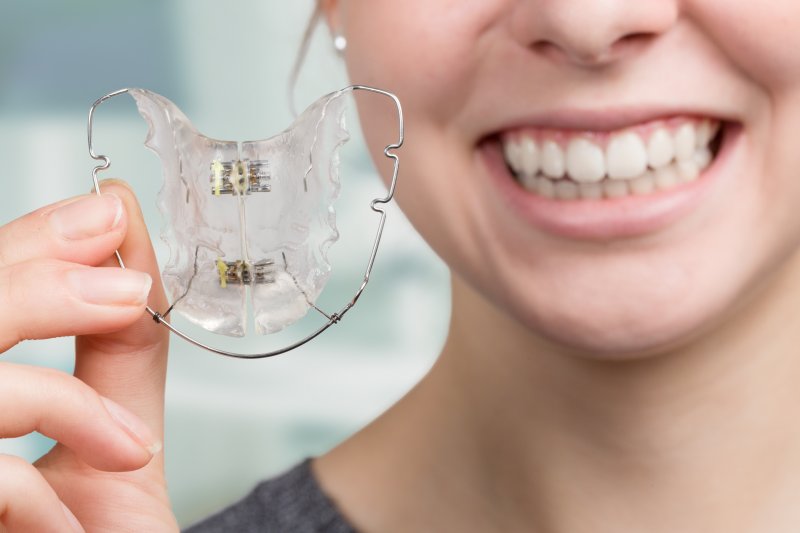Invisalign for Teens: A Modern Solution to Straightening Young Smiles
Invisalign for Teens: A Modern Solution to Straightening Young Smiles
Blog Article
Invisalign vs. Typical Braces: Which Alternative Is Right for You?
When considering orthodontic therapy, the selection in between Invisalign and typical dental braces offers a number of vital elements that merit cautious examination. Invisalign supplies a very discreet choice with detachable aligners, while typical braces give an extra visible yet reliable remedy for serious imbalance.
Overview of Treatment Alternatives

In contrast, traditional dental braces are composed of steel braces and cords that are bound to the teeth. This technique uses constant stress gradually to achieve placement. While effective for complex orthodontic concerns, conventional braces need regular visits for adjustments and can pose obstacles in preserving oral hygiene because of the problem of cleaning around cables and braces.
Both alternatives have their values, and the selection commonly rests on particular dental problems, way of life preferences, and person compliance. Inevitably, seeking advice from an orthodontic specialist is critical for identifying the most ideal therapy strategy customized to individual needs. Recognizing the nuances of each alternative can considerably affect the overall success of orthodontic therapy.
Visual Factors To Consider
A substantial factor influencing the selection between Invisalign and conventional dental braces is the aesthetic charm each therapy uses. Invisalign aligners are crafted from clear plastic, making them basically invisible when put on.
On the other hand, typical braces contain metal braces and cables, which can be more recognizable. While developments in orthodontic innovation have actually led to the growth of smaller brackets and tinted elastics, standard dental braces still keep an even more obvious profile. For some people, the visibility of braces may prevent them from looking for essential treatment.
Ultimately, the option between Invisalign and traditional braces may hinge on personal preferences pertaining to looks. Clients that prioritize discernment typically favor Invisalign, while those who are less concerned concerning exposure might go with typical dental braces. Comprehending the visual effects of each alternative is essential for making an educated choice that lines up with one's lifestyle and preferences.
Comfort and Convenience
In regards to ease, Invisalign aligners are removable, allowing people to enjoy their favored foods without constraint and keep ideal oral health. Cleaning and flossing are streamlined, as the aligners can be secured throughout these regimens, whereas standard dental braces call for mindful maneuvering around braces and blog here cables.
In comparison, conventional braces necessitate normal modifications, making them much less practical for those with busy schedules. Overall, the comfort and ease of Invisalign make it an enticing selection for many people seeking orthodontic therapy.
Therapy Duration and Performance
While both Invisalign and standard braces work in dealing with oral imbalances, the duration of therapy can vary considerably between both options. Normally, Invisalign therapy can take anywhere from 12 to 18 months, depending on the complexity of the instance. The clear aligners function by progressively changing teeth into their desired settings, and normal follow-ups with an orthodontist assistance ensure progress remains on track.
On the other hand, standard braces frequently need a longer dedication, generally ranging from 18 months to three years. This is because of their set nature and making use of cables and braces, which can be more effective for serious imbalances and intricate cases (Invisalign). The therapy efficiency of traditional braces is well-documented, as they permit precise modifications and greater control over tooth motion
Inevitably, the choice in between Invisalign and conventional dental braces may depend upon both the anticipated treatment period and the particular oral concerns at next page hand. Consulting with an orthodontist is important, as they can give customized referrals based upon individual needs, making certain the chosen method aligns with desired outcomes and timeframes.
Expense Comparison and Insurance Choices
Expense plays a substantial duty in the decision-making procedure for people thinking about orthodontic treatment, whether choosing Invisalign or standard braces. Generally, the expense of Invisalign varieties from $3,000 to $8,000, while conventional dental braces commonly set you back in between $2,000 and read what he said $6,000. Variables affecting these prices consist of the intricacy of the case, the period of therapy, and geographical place.
Many oral insurance plans give partial protection for orthodontic treatments, yet the specifics can differ commonly. Normally, standard braces may be a lot more regularly covered by insurance coverage strategies contrasted to Invisalign, which some insurers categorize as an aesthetic treatment.
In addition, several orthodontic methods use adaptable layaway plan, making both treatment choices a lot more available. Individuals should inquire regarding possible financing choices and price cuts for upfront repayments. Reviewing the total expense, consisting of insurance policy benefits and repayment strategies, is essential for making a notified choice that aligns with both visual preferences and budget plan factors to consider.

Verdict
In recap, the choice between Invisalign and conventional braces rests on numerous elements, consisting of aesthetic preferences, comfort, therapy period, and expense. Invisalign provides a discreet, detachable option that facilitates dental hygiene and nutritional adaptability, while traditional dental braces may be better for complex oral problems and frequently come at a lower price factor. Ultimately, appointment with an orthodontist is necessary to evaluate individual conditions and establish the most ideal treatment alternative for achieving optimum dental positioning.
When considering orthodontic therapy, the option in between Invisalign and standard dental braces presents a number of essential elements that warrant careful examination.Contrasting Invisalign and traditional braces exposes unique therapy options for orthodontic adjustment.While both Invisalign and typical braces are efficient in remedying dental misalignments, the period of therapy can vary significantly between the 2 options.Expense plays a substantial duty in the decision-making process for people considering orthodontic therapy, whether deciding for Invisalign or typical dental braces.In summary, the option in between Invisalign and typical braces pivots on several elements, consisting of aesthetic preferences, convenience, treatment duration, and price.
Report this page